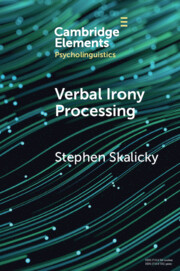Element contents
Verbal Irony Processing
Published online by Cambridge University Press: 18 January 2023
Summary
- Type
- Element
- Information
- Series: Elements in PsycholinguisticsOnline ISBN: 9781009234566Publisher: Cambridge University PressPrint publication: 02 February 2023
References
- 9
- Cited by

